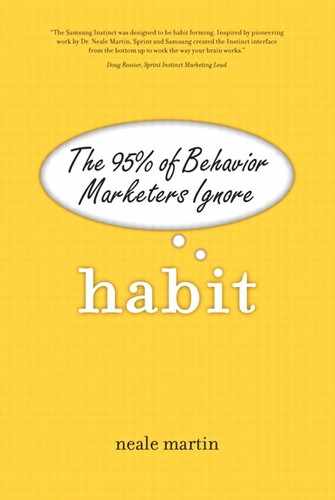Evolution and Revolution
The human mind evolved two types of mental processes to help our ancestors survive in a harsh and threatening environment: one unconscious, the other conscious. The unconscious, habitual mind is a cognitive strategy hardwired into humans as an evolutionary survival mechanism. Habit is the mind’s way of handling routine decisions to free the newer, revolutionary, conscious mind for other tasks.
The habitual mind makes us cognitively efficient. It is meant to work with the executive mind, not in opposition to it. However, it is worth noting that habit literally has a mind of its own—habits are processed and stored in the brain separately from explicitly processed information. The executive mind cannot access the workings of the habitual mind. And this is why many marketing principles don’t work.
Because we think the executive mind is in control, as if the habitual mind handles only mundane tasks, we grossly underestimate how much of our behavior is under the sway of our unconscious mind. Most of us find it hard to accept that the habitual mind controls 95% of our behavior. Yet think about almost any routine activity, such as walking on a crowded city street. We effortlessly process and react to hundreds of pieces of information—data that would overwhelm the limits of the executive mind. This is the norm, not the exception.
A useful metaphor is to think of these twin systems like the software that runs a computer. The unconscious mind is similar to an operating system, invisibly controlling the internal functions of the PC while simultaneously interacting with the surrounding environment (networks, printers, the Internet, and peripherals). The executive mind works similar to the applications, the programs that users interact with to accomplish their goals. Although we think of the application as the primary reason we use the computer, it relies on all the work the operating system is doing in the background. In addition, the application layer has a severe limitation—only one application can be active at a time.
This is the drawback of the executive mind, as well—it can think about only one thing at a time. The strength of the habitual mind is that it can process and react to hundreds of sensory inputs simultaneously without bothering the executive mind.
It’s easy to think of the applications as creating the value of the PC, just as we think that all the important thinking takes place in the executive mind. But what good is that email you just wrote if you can’t send it to someone? Similarly, to turn thought into action, the executive mind must hand off tasks to the habitual mind.
Marketers are similar to most PC users—great with executive applications, but at a loss when it comes to working with the unseen code controlling the machine.
The next chapter pulls back the curtain that veils the workings of the mind. Marketers and managers will be able to see how their current efforts work with or against the two minds of the customer.
